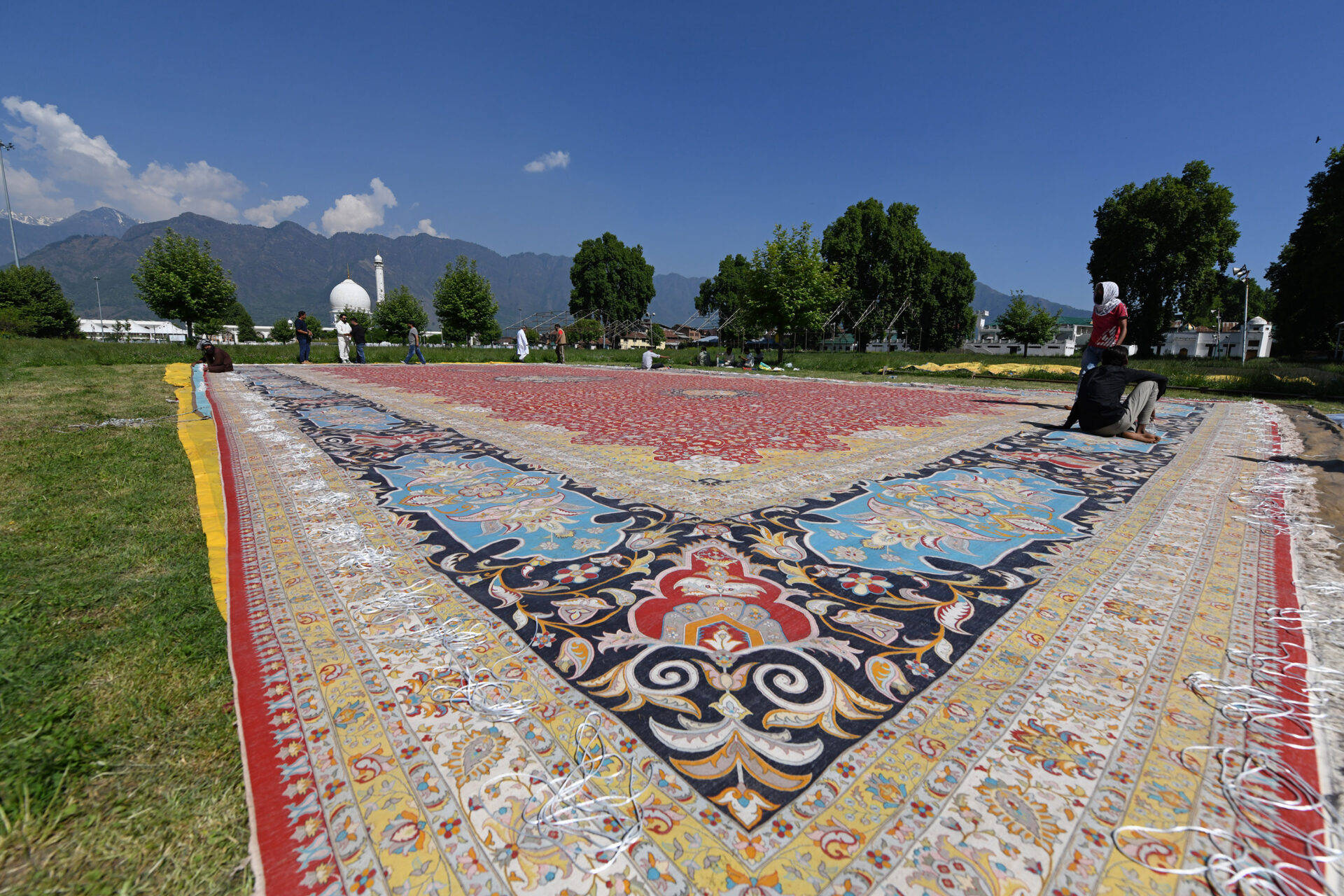In a remarkable testament to Kashmir’s rich cultural heritage and artisanal prowess, a team of skilled Kashmiri craftsmen has achieved a remarkable feat – the creation of Asia’s largest handcrafted carpet. This handwoven marvel, spanning an impressive 72 feet by 40 feet and covering a vast area of 2,880 square feet, is a true masterpiece, woven with over 37.5 crore intricate knots.
The ambitious project, which began as a vision eight years ago, required unwavering dedication and perseverance from a team of 25 master artisans. Led by seasoned craftsmen Fayaz Ahmed Shah and Abdul Gaffar Sheikh, the endeavor involved artistic dedication, significant technical innovations, and engineering feats that pushed the boundaries of traditional carpet weaving.
For years, the weavers toiled tirelessly, meticulously intertwining threads and tying knots to bring this colossal work of art to life. Their commitment and patience paid off, as the carpet emerged as a breathtaking masterpiece that not only captivates the eye but also serves as a testament to Kashmir’s rich cultural legacy and the indomitable spirit of its artisans.
Crafted in the traditional Kashan style, the carpet required engineers to remake a loom in Vailoo-Kunzar village in the Baramulla district, as Kashmir had no loom large enough for the task.They modified and joined two major looms, spreading them over a 45-feet-wide area.Cranes then lifted the carpet into large trawlers for transportation to Srinagar.
“The genesis of this extraordinary endeavor traces back to a special order placed by a fellow countryman.Inspired by the challenge, the artisans set out to push the boundaries of their craft. But it wasn’t without its challenges.The journey was fraught with obstacles, from sourcing the finest materials to overcoming disruptions caused by the COVID-19 pandemic,” the artisans said.
The creation of this unique, Asia’s largest handcrafted carpet, which is destined for export to the Middle East, features an intricate Kashan style with floral motifs, a design inspired by the Iranian city of Kashan. The monumental carpet project provided employment opportunities for around 200 artisans, allowing them to rejoin their craft.
According to weavers, floral designs are the hallmark of Kashmiri carpets, representing the region’s natural beauty. For the weavers, this largest carpet they have ever created is a true work of art, embodying the history, culture, and skills of Kashmiri artisans. “We were overjoyed. It was the biggest order we ever created. This masterpiece is a real feat for the workers,” they said.
However, the centuries-old craftsmanship is slowly witnessing a decline. that carpet weavers, numbering over one lakh, need consistent government support to keep the industry alive. “We need more support and insurance schemes. We have been working for three decades, but we do not see much benefit or future in it,”they lament, earning just Rs 9,000 per month. The work takes a toll on the artisans’ health, straining their knees, eyes, and overall well-being.
Hand-woven Kashmiri carpets date back to the 15th century when Sultan Zain-ul-Abidin brought Persian artisans to Kashmir to train local craftsmen. These carpets are renowned worldwide for their intricate designs, superior craftsmanship, and high quality. The number of knots per square inch (KPSI) is a measure of quality, with higher KPSI indicating finer details and greater durability. “This is time-consuming work. For weaving a single carpet, it takes several months to years, depending on its size and complexity, highlighting the highly labor-intensive process that requires great skill and patience.
The completion of this monumental carpet marked not just the end of a project but the beginning of a new chapter in Kashmir’s rich legacy of artistry. It stands as a testament to the resilience and creativity of its people, a beacon of hope in uncertain times.
As this magnificent carpet takes its rightful place on the world stage, it serves as a reminder of the power of perseverance, the beauty of collaboration, and the enduring spirit of Kashmir. It’s not just a carpet; it’s a symbol of unity, craftsmanship, and the indomitable human spirit. And as visitors flock to witness its splendor, they find themselves drawn not just to the carpet but to the stories of the hands that brought it to life—the hands of Vailoo village, weaving wonders for the world to behold.
Despite fluctuations in carpet production over the years, official data show a promising trend. Production stood at Rs 84.55 crore in 1990, rose to Rs 821.50 crore in 2017, dropped to Rs 299 crore in 2020-2021, and rebounded to Rs 357 crore in 2022-2023.This resurgence signifies not only the economic impact of the carpet industry but also its cultural significance in preserving Kashmir’s heritage of craftsmanship.

